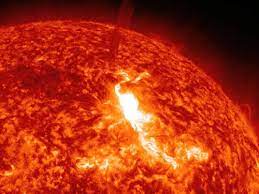Introduction:
The Sun, our nearest star, has fascinated and mystified humanity for centuries. Its brilliance and searing heat have fueled curiosity, prompting scientists and astronomers to delve into the depths of astrophysics to unravel the mysteries of its extraordinary luminosity. This extensive article explores the intricate mechanisms that make the Sun hot and bright, encompassing nuclear fusion, solar radiation, and the cosmic forces that govern our solar system’s central celestial body.
I. The Sun’s Composition: A Celestial Cauldron of Elements
- Stellar Ingredients: Hydrogen, Helium, and Beyond:
- The Sun, like other stars, is primarily composed of hydrogen (about 74% by mass) and helium (around 24%). These elemental building blocks undergo a transformative journey in the Sun’s core, leading to the release of immense energy.
- Nuclear Fusion: The Solar Furnace:
- The Sun’s core serves as a cosmic crucible where nuclear fusion occurs. Under extreme temperature and pressure, hydrogen atoms fuse to form helium, releasing an enormous amount of energy in the process.
II. The Solar Core: A Thermonuclear Inferno
- Temperature and Pressure: Extreme Conditions at the Sun’s Core:
- At the Sun’s core, temperatures soar to about 15 million degrees Celsius (27 million degrees Fahrenheit), and the pressure is so intense that it replicates conditions found in nuclear reactors on Earth.
- Thermonuclear Fusion Reactions: The Engine of Solar Energy:
- In the core, hydrogen nuclei (protons) collide and fuse, forming helium nuclei. This process, known as nuclear fusion, releases energy in the form of gamma-ray photons, providing the Sun with its intense luminosity.
III. Solar Radiation: The Journey of Light and Energy
- Photon Escapade: From Core to Surface:
- The energy generated through nuclear fusion in the Sun’s core begins a journey toward the surface. Photons, packets of light energy, slowly make their way through the dense layers of the Sun, constantly interacting with charged particles along the way.
- Radiative Zone and Convective Zone: The Sun’s Layered Dynamics:
- The radiative zone, where energy is transported by photons, gives way to the convective zone, where the transfer of energy occurs through the movement of hot plasma. This dynamic interplay of radiation and convection helps maintain the Sun’s equilibrium.
IV. Solar Atmosphere: Layers of Illumination
- Photosphere: The Visible Surface:
- The photosphere, the visible surface of the Sun, is where sunlight is born. This outer layer emits visible light and is the region where most solar phenomena, such as sunspots, occur.
- Chromosphere and Corona: Envelopes of Solar Glory:
- Beyond the photosphere lies the chromosphere and the corona. The chromosphere emits a reddish glow during solar eclipses, while the corona, an outer halo of plasma, extends into space, creating the Sun’s ethereal crown.
V. Solar Wind: The Breath of the Sun
- Solar Wind Origins: A Constant Cosmic Breeze:
- The outer layers of the Sun, specifically the corona, give rise to the solar wind—a stream of charged particles (mostly electrons and protons) that flows into the solar system, influencing the behavior of planets and other celestial bodies.
- Impact on Earth: Aurora and Cosmic Interactions:
- The solar wind, interacting with Earth’s magnetic field, produces phenomena such as the aurora borealis (northern lights) and aurora australis (southern lights). These displays showcase the dynamic relationship between the Sun and our planet.
VI. Solar Variability: Cycles of Radiance
- Solar Cycle: Sunspots and Solar Maximum:
- The Sun undergoes an approximately 11-year solar cycle marked by varying levels of solar activity. During periods of increased activity, known as solar maximum, sunspots—temporary dark regions on the Sun’s surface—become more prevalent.
- Solar Minimum: Quieter Phases of Solar Activity:
- Solar minimum, the opposite phase of the solar cycle, is characterized by a reduction in sunspot activity. This period witnesses decreased solar flare and coronal mass ejection events.
VII. The Sun’s Brightness and Color: Unveiling the Spectrum
- Visible Spectrum: A Kaleidoscope of Colors:
- The Sun emits light across the entire electromagnetic spectrum, with the majority falling within the visible range. The Sun’s apparent brightness and color temperature are a result of its surface temperature and the distribution of light wavelengths.
- Color Temperature: The Sun’s White Radiance:
- Despite its white appearance, the Sun’s color temperature is technically classified as a warm white or yellow-white, emphasizing its position as a G-type main-sequence star.
VIII. Sunlight on Earth: Life-Giving Energy
- Solar Energy Harvesting: Powering the Planet:
- The Sun’s radiant energy is harnessed on Earth through various methods, including solar panels, to generate electricity. This clean and renewable energy source plays a crucial role in sustainable practices.
- Sunlight and Photosynthesis: The Basis of Life:
- Photosynthesis, the process by which plants convert sunlight into energy, is fundamental to life on Earth. The Sun’s radiance fuels this biological mechanism, creating the foundation for terrestrial ecosystems.
IX. Conclusion: The Cosmic Crucible Illuminating Our Existence
In conclusion, the Sun’s intense heat and radiance are the result of intricate celestial processes occurring within its core. From the nuclear fusion reactions generating energy to the journey of photons through the Sun’s layered interior and the subsequent emission of sunlight, the Sun stands as a cosmic crucible of extraordinary phenomena. Its brilliance not only sustains life on Earth but also fuels our scientific curiosity, driving ongoing research into the dynamics of stellar physics. As we continue to unravel the mysteries of the Sun, we deepen our understanding of the cosmic forces shaping our solar system and the vast tapestry of the universe beyond. The Sun, our celestial neighbor, remains a constant source of wonder and illumination, both figuratively and literally, in the grand cosmic narrative of our existence.
